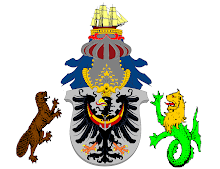
In the Ducal manor, Herzog Albrecht was re-reading dispatches from the garrison commander of Gublatz when his servant, Helmut, discreetly knocked on the doorframe. “Milord, General von Grunt has just arrived.”
“Very well,” replied Albrecht. “See that he receives refreshment. And Helmut, see that his coat gets a good brushing-off before he comes in.”
“Yes, Milord.”
Moments later, von Grunt stumped into the room, stein in hand, a valet trailing him vainly waving a clothes brush. The Graf sat heavily into the chair opposite the Herzog, staring at the floor.
Albrecht regarded him carefully for a few seconds, then waved a hand to the servants. “Leave us. And Helmut, close the door.”
As the servant’s footsteps echoed off down the hallway, Albrecht said softly, “I imagine that you think I’ve taken leave of my senses.”
After a few moments, von Grunt looked up. “I don’t understand this whole business. You placed a magazine and a depot in a border town with an under-strength garrison, and don’t give me enough reinforcements to hold them off, even though we have more than enough troops to do the job. That just invited them to come and make off with everything. We lost enough guns for the Slobbs to form four batteries of field artillery and enough rations to keep them on campaign for weeks. And you don’t seem particularly disturbed by the results.”
“Perhaps this will make you reconsider…” said Albrecht, sliding the stack of reports across the table. “Take a look through these.”
The general glared at the stack of papers, frowning. He placed the stein next to the papers and began to read, looking more confused as he flipped through the pages. “This is making less and less sense. The gun barrels were shot-out or poorly cast? Wet grain in the wagons? What is all this?” After a few moments, he started as if struck, then his face brightened. Von Grunt looked up sharply at the Herzog, who was smiling faintly at the general’s sudden understanding. “Why, you old sea-dog, it was a gambit! So they got nothing they could actually use…amazing!” He chuckled.
Albrecht sat back, a satisfied smile on his face. “That’s correct, my dear August. We have just been officially provoked into war. Now, when we annex Slobbovia not even Her Majesty in Vienna will bat an eye.”
“And the silver and iron mines…very nice.” The Graf nodded, impressed. Then he frowned. “But our losses. You could have told me, and I could have withdrawn with fewer casualties.”
“True, but we had to make it look convincing. Forgive me, my friend, but you had to give your best to defend the town. Besides, there’s another reason.” Albrecht lowered his voice. “As the old saying goes, ‘Too many ears tie a rat’s tongue.’ There are agents of the Prince here.”
“In the capital? How did you find out?”
“The RFJK is not only for police work and reconnaissance. There is of course “I” troop, made up of my most trusted men. It operates in secret and reports directly to me. I wanted to see if news of the depot would reach Prince Sergei; then I would know for certain that I had one of his agents here. The timing of the attack validated my guess that he was receiving reports from here in the capital, as well as confirming who was passing the information. As we speak, those agents are being rounded up and will vanish without a trace this night.”
Von Grunt shook his head. “Very surprising you are, milord. I’d love to be a fly on the wall in Sergei’s palace right about now.”
“As would I, August. As would I…”
“They’re WHAT!?” shouted Prince Sergei. “Unbelievable! Not even one gun usable? And ALL of the grain is spoiled? Impossible!”
Yerboudi shook his head slowly in admiration. “He out-foxed us completely. It seems that I badly underestimated this sailor Herzog, him and his intelligence people. He must have discovered our agents and fed them false information.”
“I’ll have their heads, the lot of them! Recall them immediately!”
“Right away, sire, but I doubt if any of them will survive to return. That’s how I would handle them.” mused the Sheik.
“Eh? You seem to admire this Herzog of yours a bit much, Ali. Are you sure of where your loyalties are?”
“Sergei, please. You should know better than that. I simply grant credit where it is due. The man outmaneuvered us completely, and I can admit that. Unfortunately, we just started a war we cannot help but eventually lose. We’re in the soup now, and it’s just a matter of how long can we hold out against his forces.”
“Perhaps we can wear him out by attrition.”
“Sire, that is unlikely. However, perhaps we can salvage the situation for ourselves. We can drag out the fight enough to inconvenience him, so that when we do sit down at the surrender table we can negotiate some favorable terms for you and me. Remember our ancestors’ arrangements.”
“True, it did suit both our families well enough. But how long can you stave him off?”
“A few weeks should be convincing enough. Just so it is obvious to all concerned that you didn’t just knuckle under without a fight.”







































